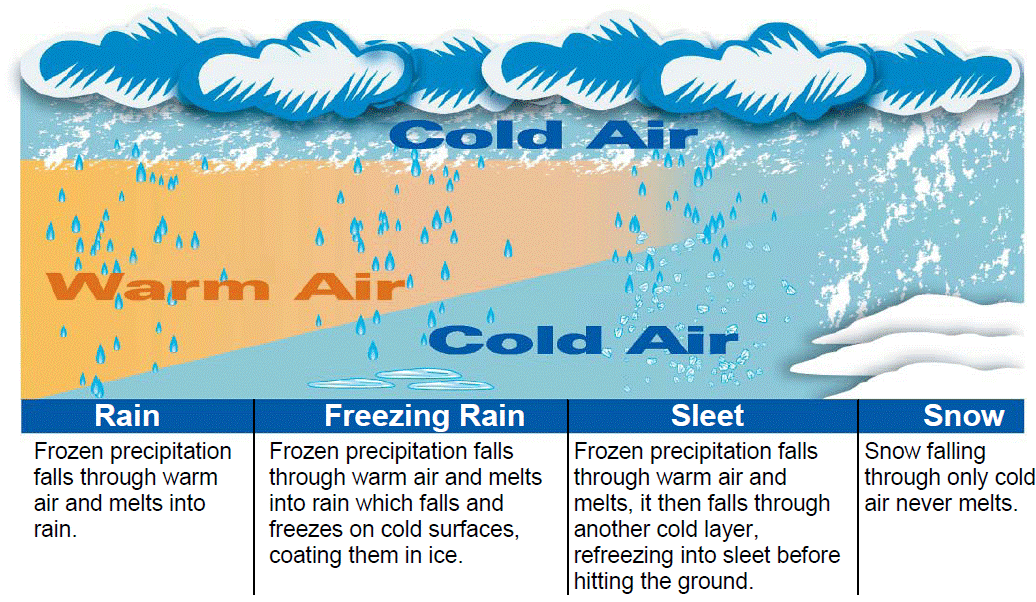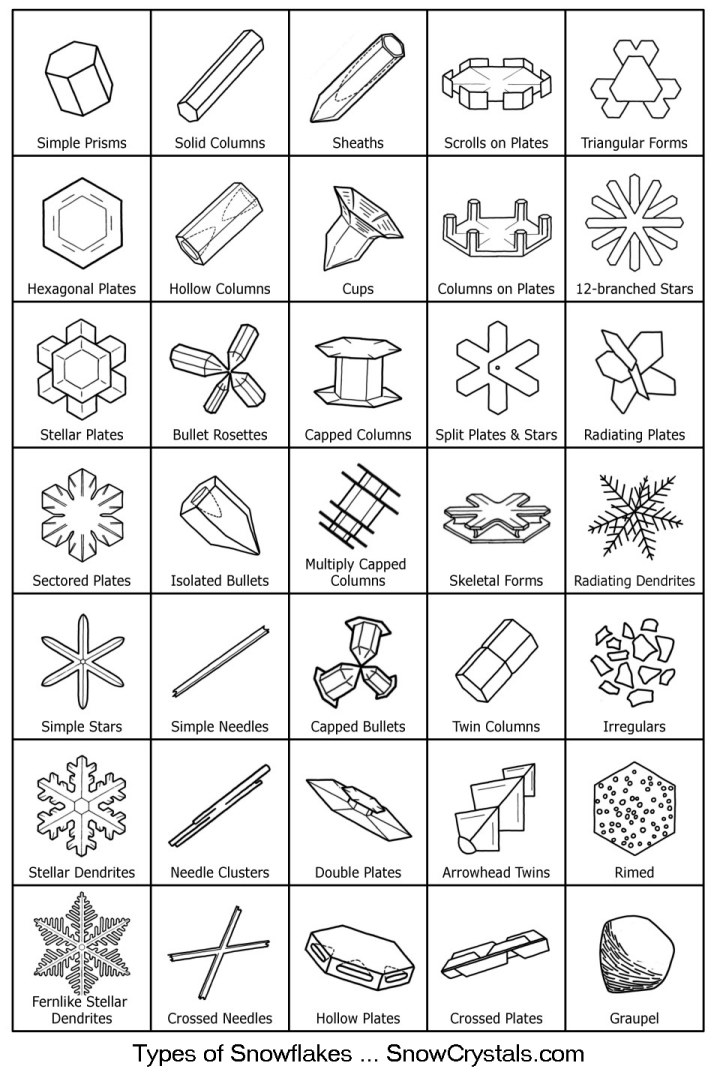The winter here at Sierra Outdoor School has been a wet one so far, as El Niño visits California this year. As several of our school groups have been here spending time learning outside in all sorts of weather conditions, we decided to share some information about how different types of precipitation are formed.
The most common types of winter precipitation are those that most people can name: rain, freezing rain, sleet, and snow. What many people are unaware of is that all winter precipitation begins as ice or snow crystals up in the cold cloud layer. If these crystals get big enough that the air rising from below can no longer support them against gravity, they begin to fall as precipitation. What they are by the time they reach the ground depends upon the air temperatures they encounter on the way down.
 |
| The four main types of winter precipitation. Source: www.weather.gov |
Freezing rain occurs when those falling rain droplets go through a shallow layer of cold air near the Earth's surface--shallow enough that they do not have time to freeze in the air, but instead freeze upon contact with the ground. This leaves a coating of glaze, or ice, and may cause dangerous travel conditions as roads freeze or the weight of the ice brings down power lines and tree limbs.
 Sleet occurs when raindrops, having melted from ice or snow crystals in the clouds, fall into a thicker or higher layer of cold air than freezing rain does. This gives them time to refreeze into ice pellets before they hit the ground. These ice pellets usually bounce, have a distinctive sound, may be spherical, and are usually transparent or translucent.
Sleet occurs when raindrops, having melted from ice or snow crystals in the clouds, fall into a thicker or higher layer of cold air than freezing rain does. This gives them time to refreeze into ice pellets before they hit the ground. These ice pellets usually bounce, have a distinctive sound, may be spherical, and are usually transparent or translucent. Snow falls when the ice or snow crystal travels through temperatures below freezing in all or most of the atmosphere from the cloud level to the surface. Large wet snowflakes occur when the snow falls through a layer of air where the temperature is above freezing, but is shallow enough that the snow does not have time to completely melt. Snow crystals come in all shapes and sizes, not just the familiar six-pointed star shape (which is called a stellar dendrite). These different shapes are shown in the chart to the right.
There are more than just these four main types of winter precipitation. One of the others that we have already experienced this winter is snow pellets or graupel (pronounced "graw-pull"), which many students think is hail. Hail is a dense ball of ice that is bigger, at least 0.5mm (or 0.2 inches) thick, and commonly is formed in a thunderstorm as strong updrafts hold the ice aloft until it grows big enough that gravity wins. During severe thunderstorms, large hailstones can cause damage and injury. Depending on the temperatures when it was being formed, hail may have clear ("hard ice" formed as the outer layer melted and refroze) and white ("soft ice" formed as other ice and snow crystals attached to it) layers if sliced open. In contrast, snow pellets or graupel are typically smaller than 0.5mm thick, are milky white, and do not need thunderstorms to form. They are made of "soft ice" and are formed as ice and snow crystals connect and merge with the surface of a partially melted snowflake on its way down to the ground.
| Graupel, or snow pellets. Source: http://quelccaya.blogspot.com |
| Large hail, with golf balls for scale. Source: www.calgarysun.com |
Resources used for this post include Precipitation Types, The Weather Channel, The Guide to Snowflakes, and The National Weather Service.
This is my first time visit to your blog and I am very interested in the articles that you serve. Provide enough knowledge for me. Thank you for sharing useful and don't forget, keep sharing useful info: Chemistry Tuition Singapore
ReplyDeleteThis is such a great resource that you are providing and you give it away for free. I love seeing blog that understand the value of providing a quality resource for free. Math worksheets for kids
ReplyDeleteThis comment has been removed by the author.
ReplyDeleteYou there, this is really good post here. Thanks for taking the time to post such valuable information. Quality content is what always gets the visitors coming. Best Online Learning Platforms
ReplyDelete